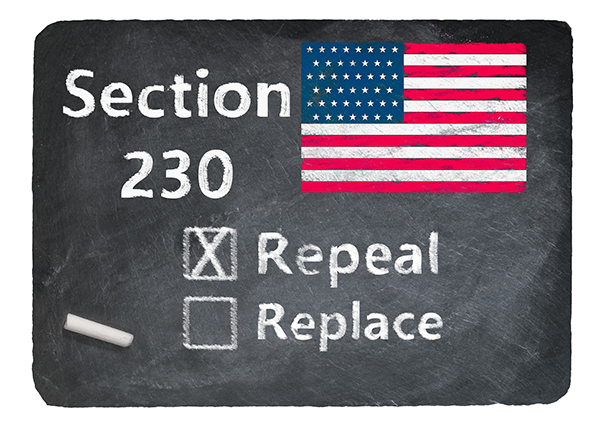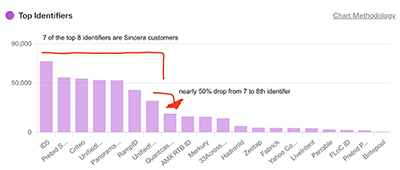 |
||||||||||||
|
||||||||||||
| The U.S. Supreme Court Is Poised to Limit Section 230 |
 |
| In 1996, Congress passed, and the Clinton Administration signed, the Communications Decency Act into law. The Act sought to limit children’s exposure to harmful content. Keen to promote the proliferation of the “startup” economy, the Act included a carve-out that protects Internet platforms, known as Section 230. This article holds that Internet platforms cannot be held liable for content posted by their users. At the same time, every platform and publisher has been free to limit the range of content that appears on their sites. For instance, some prohibit profanity, while others may be more tolerant of it. These limitations, typically memorialized in the platforms’ Community Guidelines, established rules for acceptable user behavior and content. “Now the Supreme Court is poised to reconsider those rules, potentially leading to the most significant reset of the doctrines governing online speech since U.S. officials and courts decided to apply few regulations to the web in the 1990s,” The New York Times reports. The first case concerns a Texas law that would allow users to sue large social media platforms that remove posts expressing political views. In other words, a user can sue a platform if it removes a post claiming the 2020 election was stolen. The second case involves a Florida law that makes it illegal for social media platforms to bar political candidates from posting content to their sites. The third case is a direct challenge to Section 230. That case, Gonzalez vs. Google, seeks to hold Google responsible for YouTube’s algorithm, which recommended videos inciting violence. |
| Depending on how the Supreme Court votes, these decisions can have far-reaching consequences for social media platforms and publishers (publishers are likely to be affected as many moderate their Readers’ Comments section for factuality and intent). Supporters of Section 230’s repeal and the Florida and Texas laws cite free speech as the motivating factor. These critics of social media moderation claim that removing posts violates the First Amendment of the US Constitution. In truth, the First Amendment protects people and the press from government infringement of their speech, the right to peaceably assemble, as well as petition the government for a redress of grievances. It’s absolutely silent on non-governmental organizations, such as Internet platforms. Should the “free speech” activists prevail, social media platforms and news organizations would effectively be barred from establishing meaningful oversight over the content that users publish to their properties? These bans come at a time when most people can’t identify fake news. |
| Twitter’s Referral Traffic — and Revenue — on the Decline |
 |
| “Not all moments last. As of today, we’re removing the option to create Moments for most users as we focus on improving other experiences,” read a December 7, 2022 tweet from Twitter Support. “Don’t worry, you can still see past Moments and follow Live events on Twitter.” For many publishers, the end of Twitter Moments spelled the decline of a valuable stream of referrals and revenue opportunities, Digiday reports. The publisher cites an analysis by Automattic that found a widespread decline. “Automattic analyzed a random set of 21 large and small publishers and found that the sites’ traffic from Twitter in the fourth quarter fell, on average by, 13%. Of that data set, 71% of publishers saw their traffic decline.” Similarweb, a data analytics company that monitors web traffic, also measured a decline in referral traffic. According to its analysis of a dozen publishers, Twitter referral traffic showed a 12% decline from November to December. While many publishers lament the loss of Twitter Moments, regional news outlets are particularly hard hit. One such publisher told Digiday, “The big, scary, existential question is, will social media continue to be a traffic source for a news organization? Or will it become just a storytelling platform or just a marketing platform?” |
| Social media is at a crossroads in terms of how it works with publishers and promotes news stories. Almost since the beginning, social media platforms have leveraged publisher content to attract and monetize users via its share button on publisher sites and by stories shared by users and the platforms themselves in newsfeeds. This historical emphasis on the news has taught many people to rely on social media as their primary news source. Now social media sites are moving away from journalistic content. When Meta announced the elimination of Facebook News, a spokesperson told Axios, “??Most people do not come to Facebook for news, and as a business, it doesn't make sense to over-invest in areas that don't align with user preferences.” Facebook News helped elevate content for users and provided direct payments to publishers (over a three-year period, Meta paid $105 million to select news publishers and another $90 million for news videos). While eliminating Twitter Moments is likely the result of Elon Musk’s desire to achieve a less cluttered Twitter, it comes at a great cost to many national and regional news organizations that rely on it to boost readership. These changes come at a perilous time. Researchers warn of a significant rise in news avoidance. In its annual Digital News Report, Reuters Institute found consumption of news media has declined, and interest in news “has fallen sharply across markets, from 63% in 2017 to 51% in 2022.” News consumption may decline further once people are no longer exposed to journalism on social media. |
| Generative AI: Ad Tech’s New Artificial Frontier |
 |
| We have an encrypted message from bots ChatGPT and DALL-E 2: “Prepare for imminent takeover.” The ad tech industry has used AI and Machine Learning technology for years. From predictive modeling to real-time campaign optimization to automating tedious manual tasks, to DSPs using the technology to determine which bids they might win. More recent uses include leveraging AI to use data more efficiently and also the sell-side's use of AI to organize and tag inventory. But generative AI is poised to change the ecosystem in a massive way. Industry experts believe that generative AI, a subtype of artificial intelligence, will disrupt every aspect of advertising, from brainstorming to copywriting to targeting ads. The technology, as the name suggests, generates content. The content ranges from images, videos, text, audio, and other mediums. Currently, the most popular forms of generative AI are ChatGPT and DALL-E 2. The most popular platform, ChatGPT, takes text-based inputs and generates text-based outputs. Whereas DALL-E 2 takes text-based inputs and generates picture-based outputs. With ChatGPT, the user will insert questions such as “What is the seventh wonder of the world?” or “How do I create an NFT for purchase on the crypto exchange?” It even allows you to be creative and produce novel material based on super-specific entries such as, “Can you write a story about Afrofuturism, in the style of a Prince song?” The opportunities for creative and practical use are expansive, but generative AI does have its limits. |
| When ChatGPT launched last year, many tech companies thought this new technology would disrupt their businesses, but Microsoft thought differently. They invested $1 billion into OpenAI — the company responsible for ChatGPT — before it was even created. The tech behemoth plans to incorporate ChatGPT into its Bing search engine, Office apps — Word, PowerPoint, and Outlook — as well as its Azure Cloud Service. In addition to Microsoft, publishers and advertisers are starting to see the practical use of generative AI when creating marketing campaigns. The most common use for generative AI in marketing strategies is for idea generation. Others are using the tech to create ready-to-go advertisements. For example, Ryan Reynolds released an ad for Mint Mobile that ChatGPT partially wrote. Like any new technology, there are some kinks to work out with generative AI. The most pressing concern is misinformation. The tech is only as good as the data it is given. If the data is false, biased, or corrupted, the generated content will also be. OpenAI admitted that while some ChatGPT answers may sound plausible, there have been cases where the generator was completely wrong. There are also privacy concerns. How do consumers feel about these AI bots knowing their personal information? We already have evidence of malicious bots generating malware. Bad actors are already hacking away at ChatGPT to see what kinds of mischief they can make. Generative AI has many practical benefits, but protective measures must be implemented to protect consumers and the brand safety of publishers and advertisers. |
| Around the Water Cooler: Misinformation; Tech and Media Layoffs |
 |
| And, just in case you missed it... What Anonymization Techniques Can You Trust? Many legacy techniques used to anonymize data fail horribly. So which ones can we really trust? (Tumult Labs) Why Misinformation Is Here To Stay With the proliferation of fake news, misinformation will continue to be a headache in 20223 and beyond. But there's gotta be a way we can curtail the problem. (Forbes) What the Tech and Media Layoffs Are Really Telling Us About the Economy About 130,000 people have been dismissed from their jobs at large tech and media companies in the past 12 months. But the overall unemployment rate in the U.S. is 3.5 percent. Why are the tech and media industries bleeding in comparison? (The Atlantic) Google Is Increasingly Turning to Resellers As It Conducts the Largest Round of Layoffs in Its History As Google plans to cut 12,000 jobs, reports are surfacing that Big G is increasingly encouraging advertisers to engage with its network of approved resellers. This would help the tech giant reduce their advertising services operational costs and better position itself as a SaaS company. (Digiday) |
 |
|||||||
|
|||||||
 |
|||||||
 |
|||||||
|







